Has anybody been in a situation where a chronic branch suspensory injury, no tears, no ruptures, but yes to boney changes, on a hind leg has been shod in an aluminum suspensory branch shoe, but the hoof angle has gone negative and the current shoeing setup is now irritating the stifles? This is not a weak stifles issue, but rather a change in the mechanics. For this horse, low angles create more of a post-leg and starts a cycle of stifle soreness progressing to SI joint soreness. However, the farrier is adamant that he stay in the current set-up and has talked the vet into it. The farrier believes we absolutely must float that toe and let the heel sink. It is really so bad to go to level on the hinds if the horse just can’t keep his angles correct, and it is causing bigger problems? I wanted a one degree full wedge pad for the prolapsed frogs and a wide web shoe to support the heels and bring the hoof back to level. The vet thought this was very appropriate, and we were going to wait a month for the legs to settle into the new configuration before continuting rehab after another OSPHOs and shockwave treatment. That plan has gone out the window since the farrier is not on board, and it seems like it is a foregone conclusion the status quo is what we are doing. Thoughts about shoeing for a suspensory injury on a horse with negative hoof angles? Are there other options?
Low angles always start straightening the hocks, and usually start leading to NPA.
I don’t understand the farrier’s reasoning at all, but am not too terribly surprised a vet is ok with it
NPA is never helpful. Ever. It is always harmful. Always.
Thank you JB. I have a more experienced farrier coming out next week who knows and works well with the vet, and he has some ideas about how to support the hoof while addressing a suspensory that is not acute. I thought this was a really important distinction along with questions about what kind of suspensory damage is being addressed. He said, as you have pointed out, the mechanics of how the horse goes is a whole system, but he has had very good results with other types of shoes that will support the leg without changing the angles. I really liked that he explained to me that the shoe inhibits the toe grabbing at a certain phase of the stride where the suspensory comes into play at the highest loads and is particularly vulnerable, hence “floating the toe”, but he is still thinking about the whole design of suspensory branch shoe and how much it really helps.
Just because I struggled to understand, I looked at a chart on suspensory loads during the different phases of the stride (in trot? I will have to go back and look), and it was interesting. Plots of “normal shoes”, “toe wedge”, “heel wedge” suspensory strain at different parts of the flight, there wasn’t that much difference at peak load, or the top of the curve. Maybe “toe wedge” releases about 2% of the strain on the suspensory. So, it is not like these shoes by dropping the heel and releasing the toe are making that huge of a difference.
[URL=“https://www.ncbi.nlm.nih.gov/pmc/articles/PMC2375746/”]https://www.ncbi.nlm.nih.gov/pmc/articles/PMC2375746/
Thank you for being so clear and direct.
I support your decision to work with another farrier. If nothing else, it is good to get a second opinion.
I’d also think a low heel and a longer toe would cause more stress on the suspensory.
New farrier please.
I’m finding lots of these negative hoof angled-horses just aren’t being trimmed properly. Whether it’s a change in farrier style (remember when long toe, low heel was popular about 15 yrs ago? and prior to that, everything had a ‘trailer’ behind?) or just this one farrier’s way of doing things. A change is oftentimes good for the horse.
You also may consider how the horse is being ridden. Enduring hind suspensory issues are usually attributable to riders who ride the horse backward and dont ask them to carry themselves properly.
Lastly, since you’re mentioning a few areas of suspected soreness - how old is this horse? Is there a possibility he’s leaning toward being cushingoeid?
Wow, you guys are good. THis horse was diagnosed with Intermittend Upward Fixation of the Patella after an accident in the washrack where he almost when down into the splits. His stifle started locking really badly, liking dragging the leg, back him up to unlock. Then within a few months he was short striding in the trot on the same leg. Diagnosis was not injury but rather hind end weekness. Estrone, lots of hind end work, more estrone, suggested blistering, suggested patella splitting, all this went on for two years. Did no blistering and no splitting. Finally, the horse couldn’t trot and could hardly walk under saddle. Ultrasound showed an OCD lesion at the MTR, so off to surgery. The joint was cleaned up, locking went away, but the short striding on that leg could never be, as perscribed, “worked through”. Vet did PRP, IRAP, and Noltrex as conjunctive therapies immediately following surgery. He went off to the treadmill and a trainer long lined him for a month even though the vet said he was ready for under saddle trotting. He looked good under saddle for about a month, and then back to short striding and now a very sore back. We coudn’t get him sound four months post surgery; we were so discouraged we turned him out for a year. He had no kissing spine. He did get pretty bad ulcers, scoped, from three months of Previcox and struggling with rehab, I imagine.
I find a new surgeon who blocks from the bottom up, which I didn’t know that is what you do, and did a full flexion test to include the fetlock, and wha la - it is chronic suspensory, branch high and low, no tears no holes, boney changes. After two treatments of shockwave and a round of Osphos, we are at ground zero. He is crooked, stiff, and I don’t want to ride him. There is no way he can stretch or round up like this. So, the low angles, good place to start. The horse is now ten years old. The accident happened at age 4 1/2. He has been a pasture horse for the majority of the last three years, and it is good to know that it was not all in his head; riding him hurt him.
You wouldn’t happen to have hoof pictures for us would you? Those would be interesting to see. I find that the angles you’re describing cause sore tight hamstrings, lower back and SI soreness.
I would say you are well past the current farrier’s ability or care. He either didn’t see these imbalances developing or didn’t care.
This is not a horse for him to learn on with this thing. Your horse needs those angles fixed asap with whatever trim and orthotic combo gets it done now, and the trim is done well every 4-5 weeks so the feet make progress.
I feel your pain on years of rehab :no:
Oh, thank you JB! Here is the update. New farrier came out today, and it was absoutely the right decision. I was shocked when the new farrier asked me trot the horse in hand sans one shoe on the bad suspensory/stifle side. He pulled it two days ago stepping all over himself in the stall. I thought, oh, he is going to be so gimpy. Ha! He trotted big, beautiful, and then passed me! I wasn’t expecting it! Zero dragging of the hind end. The old suspensory specialty shoes are very similiar to those used for collateral ligament issues, so maybe this was just not a good shoe for this horse. He is now shod in a eggbar with spider plates and dental impression material. The shoe is set back under the boney column of the hoof to give support to the suspensory. There is a little bit of a shaped trailer. I don’t think he lifted the angles from negative so much as supported the prolapsed frog and gave more support to the heels. He couldn’t trim him much because he had just been done a week ago. Trotted the horse post-shoeing in hand, and he seems to be fine with the changes so far. We will see what more he has to say under saddle and go from there.
Talked to old farrier immediately after as he finally got in touch with me, and he did not take it well that I consulted someone else even though I laid out the case again for more experience and more options. I explained how I tried to work this out with him and the vet, but ultimately I felt locked out of the decision-making process. The feedback was pretty much the same, there will be no success with suspensory treatment without the heel being able to drop, and a rim pad wouldn’t last very long on this horse. I conceded that the new set-up might not work for the hind suspensory, but at least it is well thought out try, and the stifles are going to really appreciate it.
Thank you, everyone, for your help.
Boyle Heights Kid, you are so right in that thought. The hamstrings and neck muscles were like rocks. Old set-up pics below. Need to go take some pics. [ATTACH=JSON]{“alt”:“Click image for larger version Name: Hind Bottom.jpg Views: 0 Size: 12.7 KB ID: 10690491”,“data-align”:“none”,“data-attachmentid”:“10690491”,“data-size”:“full”}[/ATTACH][ATTACH=JSON]{“alt”:“Click image for larger version Name: Short Shod 4.15.2020.JPG Views: 0 Size: 27.0 KB ID: 10690489”,“data-align”:“none”,“data-attachmentid”:“10690489”,“data-size”:“full”}[/ATTACH][ATTACH=JSON]{“alt”:“Click image for larger version Name: IMG_3806.jpg Views: 0 Size: 12.3 KB ID: 10690490”,“data-align”:“none”,“data-attachmentid”:“10690490”,“data-size”:“full”}[/ATTACH]
The old farrier did some good things, but a change in set-up was, I thought, needed. Again above is the old set-up, hinds at one week, and fronts at four weeks. Ended up on two different shoeing cycles to leave the fronts on a little longer. Didn’t need to glue on the fronts today at five weeks, so that was good.
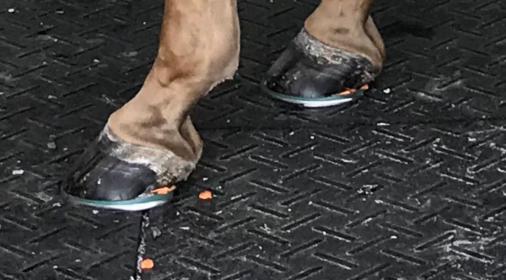
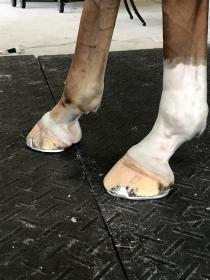
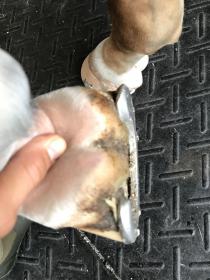
Oh, thank you JB! Here is the update. New farrier came out today, and it was absoutely the right decision. I was shocked when the new farrier asked me trot the horse in hand sans one shoe on the bad suspensory/stifle side. He pulled it two days ago stepping all over himself in the stall. I thought, oh, he is going to be so gimpy. Ha! He trotted big, beautiful, and then passed me! I wasn’t expecting it! Zero dragging of the hind end. The old suspensory specialty shoes are very similiar to those used for collateral ligament issues, so maybe this was just not a good shoe for this horse. He is now shod in a eggbar with spider plates and dental impression material. The shoe is set back under the boney column of the hoof to give support to the suspensory. There is a little bit of a shaped trailer. I don’t think he lifted the angles from negative so much as supported the prolapsed frog and gave more support to the heels. He couldn’t trim him much because he had just been done a week ago. Trotted the horse post-shoeing in hand, and he seems to be fine with the changes so far. We will see what more he has to say under saddle and go from there.
Talked to old farrier immediately after as he finally got in touch with me, and he did not take it well that I consulted someone else even though I laid out the case again for more experience and more options. I explained how I tried to work this out with him and the vet, but ultimately I felt locked out of the decision-making process. The feedback was pretty much the same, there will be no success with suspensory treatment without the heel being able to drop, and a rim pad wouldn’t last very long on this horse. I conceded that the new set-up might not work for the hind suspensory, but at least it is well thought out try, and the stifles are going to really appreciate it.
Thank you, everyone, for your help.
Oh, thank you JB! Here is the update. New farrier came out today, and it was absoutely the right decision. I was shocked when the new farrier asked me trot the horse in hand sans one shoe on the bad suspensory/stifle side. He pulled it two days ago stepping all over himself in the stall. I thought, oh, he is going to be so gimpy. Ha! He trotted big, beautiful, and then passed me! I wasn’t expecting it! Zero dragging of the hind end. The old suspensory specialty shoes are very similiar to those used for collateral ligament issues, so maybe this was just not a good shoe for this horse. He is now shod in a eggbar with spider plates and dental impression material. The shoe is set back under the boney column of the hoof to give support to the suspensory. There is a little bit of a shaped trailer. I don’t think he lifted the angles from negative so much as supported the prolapsed frog and gave more support to the heels. He couldn’t trim him much because he had just been done a week ago. Trotted the horse post-shoeing in hand, and he seems to be fine with the changes so far. We will see what more he has to say under saddle and go from there.
Talked to old farrier immediately after as he finally got in touch with me, and he did not take it well that I consulted someone else even though I laid out the case again for more experience and more options. I explained how I tried to work this out with him and the vet, but ultimately I felt locked out of the decision-making process. The feedback was pretty much the same, there will be no success with suspensory treatment without the heel being able to drop, and a rim pad wouldn’t last very long on this horse. I conceded that the new set-up might not work for the hind suspensory, but at least it is well thought out try, and the stifles are going to really appreciate it.
Thank you, everyone, for your help.
Thanks for the pictures… will be curious to see the new set up. You might want to get him some body work and maybe the chiro as well and hopefully the new farrier can make the improvements he needs… I wonder if maybe some of what’s going on behind is because of how the fronts are set up. There is a bit going on there as well with long toes and jamming at the quarters, which suggests quarters and heels are too long.
OP, please do continue to update us. It’s always interesting to learn.
I would also want to recommend Dr. Gillis: http://www.equineultrasound.com/
Her consulting fee is reasonable and I think she really helped by boy recover from his chronic proximal suspensory injury. Local vets tend to rush the return to work, I think.
Do keep us updated, and I would also love to see the new set up! What a relief it is to have a farrier that listens and is knowledgeable.
I just can’t wrap my head around how lowering the heel could in any way help the suspensory ligament. I’ve seen an eggbutt setup similar to what you describe help, so hopefully that gets you back on the right track.
Oh goodness. OK, so here are more pictures of the old set-up. I say oh goodness, because apparently no body wants to step on anyone’s toes, and the horse is paying the price. Anyhow, onward and upward:
An option for low heels is this full rocker motion shoe which was glued on the the fronts, and now is off. (Next post will be the new front set-up.) So, my question is this, would you put a full rocker motion shoe on a horse with a suspensory injury on a hind limb? Would you put a full rocker motion shoe on a horse with very long toes? Second question, if you really wanted that toe to float and heel to sink, would not even consider using a suspensory shoe that is not asymmetrical? The manufacturer says that this shoe is to be used with the narrow branch for “Subchondral compression bone lesions (narrow branch on the side of the lesion to reduce pressure). Desmopathy of collateral ligaments (wide branch on the side of the lesion to reduce tension).” They also sell this same shoe as the Suspensory Ramix. They do have a suspensory shoe that does not have the wide branch at all.
However, the vet will not entertain anything but the wide branch under the suspensory, and he says that my horse does not have a fetlock subchondral bone lesion. He says the bilateral medial trochlear ridge bone lesions on the stifle are something else, so I guess the stifle doesn’t count. The stifles do have bilaterial, unfilled, subchondral bone lesions. Unfortunately, he and the last vet worked together at the same practice before going off on their own the last few years. Maybe this is the “don’t step on anyone’s toes” thing, and I am being put in my place.
More pics of old set-up.
[ATTACH=JSON]{“data-align”:“none”,“data-size”:“large”,“data-attachmentid”:10692025}[/ATTACH][ATTACH=JSON]{“data-align”:“none”,“data-size”:“large”,“data-attachmentid”:10692023}[/ATTACH]
https://www.michel-vaillant-marechal…7-g-unit-price
Pics of new set-up next post addressing the low heels, negative angles, on the hinds and long toes, collapsed heels on the fronts. The vet is just not going to acknowledge that changing farriers might be a good idea. Talked to the new farrier who knows and has good things to say about this new vet, but vet claims he has met him once and can not attest to his work. That makes things really awkward. Please forgive any typos.
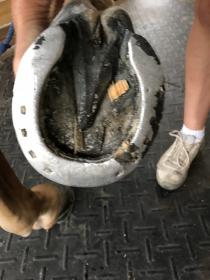

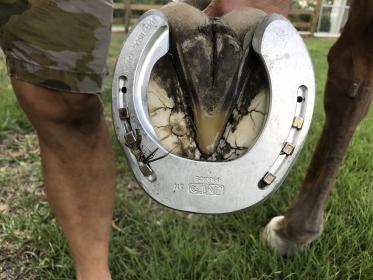
Oh goodness. OK, so here are more pictures of the old set-up. I say oh goodness, because apparently no body wants to step on anyone’s toes, and the horse is paying the price. Anyhow, onward and upward:
An option for low heels is this full rocker motion shoe which was glued on the the fronts, and now is off. (Next post will be the new front set-up.) So, my question is this, would you put a full rocker motion shoe on a horse with a suspensory injury on a hind limb? Would you put a full rocker motion shoe on a horse with very long toes? Second question, if you really wanted that toe to float and heel to sink, why wouldn’t you consider using a suspensory shoe that is not asymmetrical? The manufacturer says that this shoe is to be used with the narrow branch for “Subchondral compression bone lesions (narrow branch on the side of the lesion to reduce pressure). Desmopathy of collateral ligaments (wide branch on the side of the lesion to reduce tension).” They also sell this same shoe as the Wide Branch Suspensory Ramix. They do have a suspensory shoe that does not have the wide branch at all.
However, the vet will not entertain anything but the wide branch under the suspensory, and he says that my horse does not have a fetlock subchondral bone lesion. He says the bilateral medial trochlear ridge bone lesions on the stifle are something else, so I guess the stifle doesn’t count. The stifles do have bilaterial, unfilled, subchondral bone lesions. Unfortunately, he and the last vet worked together at the same practice before going off on their own the last few years. Maybe this is the “don’t step on anyone’s toes” thing, and I am being put in my place.
More pics of old set-up.
[ATTACH=JSON]{“data-align”:“none”,“data-size”:“large”,“data-attachmentid”:10692029}[/ATTACH][ATTACH=JSON]{“data-align”:“none”,“data-size”:“large”,“data-attachmentid”:10692027}[/ATTACH]
https://www.michel-vaillant-marechal…7-g-unit-price
Pics of new set-up next post addressing the low heels, negative angles, on the hinds and long toes, collapsed heels on the fronts. The vet is just not going to acknowledge that changing farriers might be a good idea. Talked to the new farrier who knows and has good things to say about this new vet, but vet claims he has met him once and can not attest to his work. That makes things really awkward. Please forgive any typos.



Wrong side picture on the fronts, Sorry. [ATTACH=JSON]{“data-align”:“none”,“data-size”:“large”,“data-attachmentid”:10692037}[/ATTACH] So, I was looking at the picture of the fronts and wondering why I was seeing orange dental impression. Then I discovered that was the shoeing prior to the full rocker motion shoe when the farrier was using some frog support. Then he decided he had to use glue-ons because the orange dental impression shoe,pictured erroneously above, came off within days.
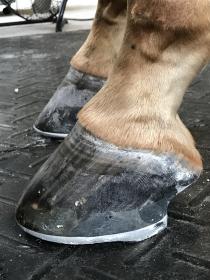
Is this the new set up?
